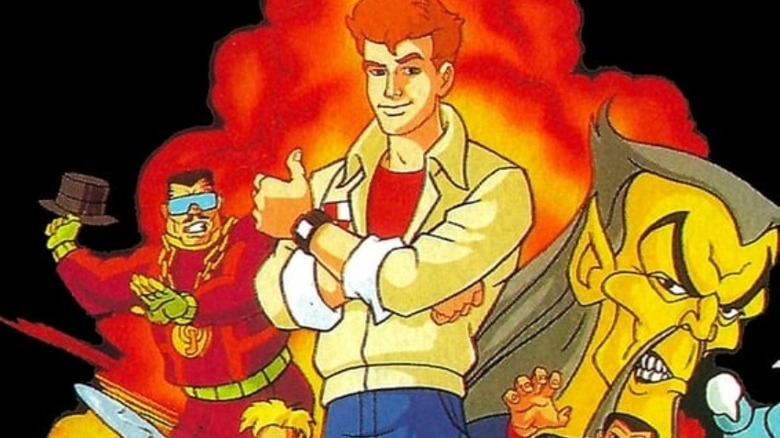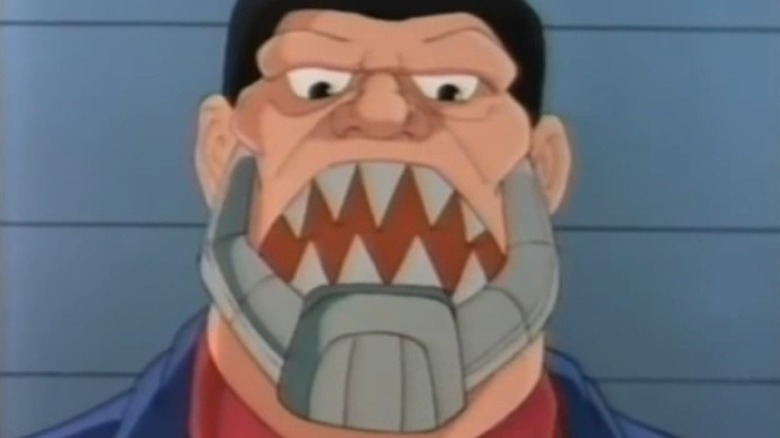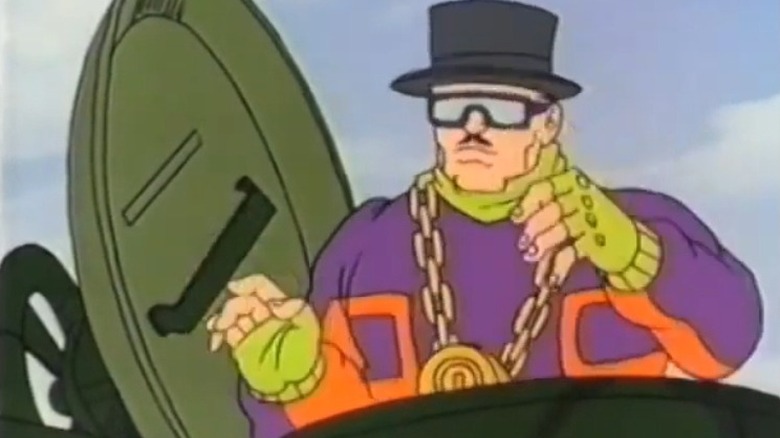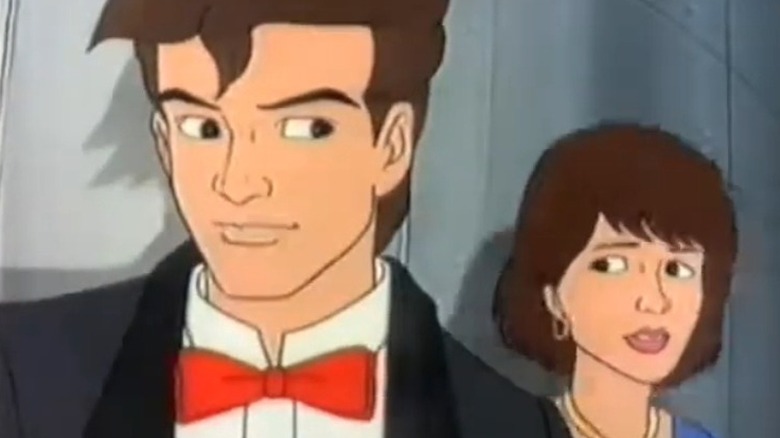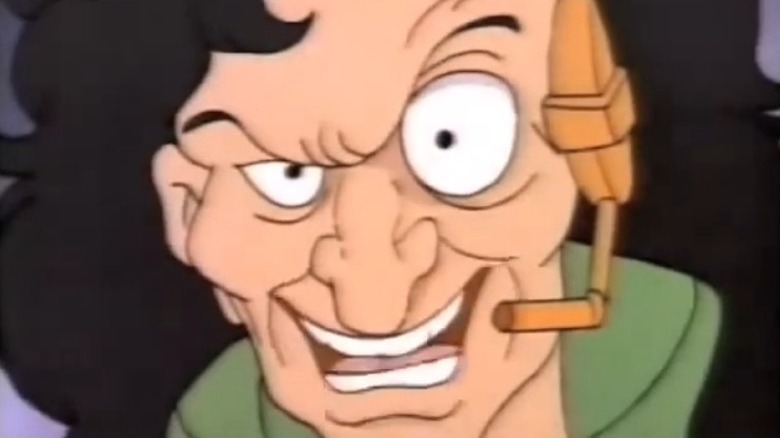The Obscure Animated Series That Rewrote James Bond History
To clarify right away, James Bond, Jr. (Corey Burton), the title character from a barely-remembered 007-adjacent 1991 animated series, is not the son of James Bond. More confusingly, James Bond, Jr. is actually the nephew of James Bond. "He learned the game from his uncle James," the theme song makes very clear. This means that James Bond did indeed have a brother, but also that his brother was named James as well ...?
As of this writing, "James Bond Jr." is the only TV adaptation to date of Ian Fleming's ultra-popular James Bond book series. It came at a fascinating time in the history of the James Bond franchise, as Timothy Dalton's two-film run had come to an end, and a messy rights dispute behind the scenes kept Bond off the big screen for years. It also likely didn't help that the Berlin Wall fell in November of 1989, calling the need for a spy character like James Bond into question. The gap allowed a popular animation studio, Murakami-Wolf-Swenson ("The Point," "Free To Be You and Me," "200 Motels"), to step in and take advantage of James Bond's TV rights, which weren't tied up with the film rights.
Danjaq, the company founded by Albert Broccoli and Harry Saltzman to handle Bond properties, teamed with Murakami-Wolf-Swenson to make "James Bond Jr.," a daily animated series that lasted 65 episodes from September 1991 until the following March. The series invented a whole extended family for James Bond (a family that was refuted by Fleming's own novels) and expanded the James Bond universe to include Warfield Academy, a spy school that James Jr. was attending on his way to becoming a proper MI-6 agent. The show also featured the son of Felix Leiter and the grandson of Q.
The Adventures of James Bond Junior 003½
Apologies for the low quality of the images, but "James Bond Jr." has not been remastered or even carefully archived, so the only available episodes are VHS-quality dubs pirated onto YouTube.
"James Bond Jr." was, one might be surprised to learn, an idea a long time in the making. Way back in 1967, an author named R.D. Mascott authored a kid-friendly James Bond novel in the style of Ian Fleming called "The Adventures of James Bond Junior 003½." It was Mascott who posited that James Bond had a nephew who was also named James Bond, even though Fleming noted multiple times that James Bond was an only child and couldn't have a nephew. It was reported in the New York Times in 1966 that Mascott's novels were being pursued for a TV adaptation, likely to tap into a sudden boom of kid-friendly action programs like "The Avengers," "Batman," and "The Green Hornet." That project fell through, and the idea wouldn't be resurrected for another 25 years.
Apart from the title character, and its setting at an exclusive spy school, Mascott's novel doesn't share any details with the 1991 TV series.
The TV series, instead, was a legacy show about the descendants — or returns — of known 007-universe characters. Q's grandson, IQ (Jeff Bennett), was an inventor who gave James Jr. his spy gadgets. Felix Leiter's son was named Gordo (Jan Rabson), and he was a typical American surfer dude (common in the children's media of the era). James was dating a young woman named Tracy (Mona Marshall), who was named after (but is not related to) Diana Rigg's character from "On Her Majesty's Secret Service." Also present was James' and Tracy's observant friend Phoebe (Susan Silo).
S.C.U.M.
The show's rogue's gallery was an evil S.P.E.C.T.R.E.-like organization called Saboteurs and Criminals United in Mayhem, or S.C.U.M. Some familiar 007 villains were members of S.C.U.M. including Jaws (Rabson), the character played by Richard Kiel in "The Spy Who Loved Me" and "Moonraker," and Oddjob (Bennett), played by Harold Sakata in "Goldfinger." Oddjob, previously a fan of formal black suits was given a Flava Flav makeover for "James Bond Jr.," and now sported a purple and orange tracksuit with chartreuse accents and a massive gold medallion. He wore Oakley-style sunglasses. His razor hat was left intact. Auric Goldfinger (Rabson), previously played by Gert Fröbe, also came back but now had a daughter named Goldie (Kath Soucie).
Dr. No (Julian Holloway) returned from the first "official" Bond movie, but this time had green skin and ... Well, his character design was, quite regrettably, based on broad Asian stereotypes. Nick Nack, the character played by Hervé Villechaize in "The Man With the Golden Gun" was also given a massive redesign and was typically paired with Jaws.
The show's other, newer villains were in a more, well, cartoonish mode. James Jr. also faced off against Baron von Skarin (Julian Holloway), a pirate named Walker D. Plank (Ed Gilbert), the hilariously named Tiara Hotstones (Marshall), and the large-headed Maximillion Cortex.
"James Bond Jr." also continued the tradition of the "Bond Girl," just with the sexuality removed to accommodate the Saturday morning audience of kids. Bond would rescue women with names like Lotta Dinaro, Terri Firma, Hayley Comet, and Marci Boucoup. The episodes usually involved James Jr. discovering some dastardly S.C.U.M. plot in the ordinary course of his school days at Warfield Academy, and his subsequent sneaking off to stop them. He drove his uncle's old Aston Martin.
Nobody does it better
In the 2020 oral history book "Nobody Does it Better: The Complete, Uncensored, Unauthorized Oral History of James Bond," edited by Mark A. Altman and Edward Gross, one of the writers of "James Bond Jr.," Terrence McDonnell, went on record as to the nature of the series and the challenges he faced writing it. His goal, he said, was to cram into 30-minute episodes the same kind of story that James Bond might have faced in a full-length feature film, going so far as to remember one notable episode that he liked. McDonnell said:
"I think the biggest challenge of writing 'James Bond Jr.' was to devise a storyline that sounded like it could have made a decent Bond movie. One was called 'Avalanche Run' and was set during a winter vacation for James and his friends in the Swiss Alps. The Bond girl in this one is a young woman named Bunny Slopes, whose father is the engineer on the express train that is scheduled to take James and his friends back."
McDonnell recalled with clarity that Jaws seized the controls of a train and sought to crash it into a nuclear power plant. Exciting stuff! McDonnell also regretted that "James Bond Jr." is largely being ignored by modern Bond scholars, lamenting:
"The fact remains that after almost 30 years, this show about James Bond — or rather, his nephew — has never officially been released on DVD to the public as far as I know. If it's true, that says a lot. Maybe someday everyone will get a chance to see it, maybe not. Maybe the owners want to leave it and let it die a quiet death. [...] Hardly what we've come to expect from the spare-no-expense franchise."
Where'd it go?
For its brief, 65-episode run (all saved by freelance archivists on YouTube), "James Bond Jr." was moderately successful. It came packaged with a Hasbro toy line which included cars and action figures. ERTL put out a line of "James Bond Jr." die-cast cars, and Crown & Andrews even produced a board game. Some kids might even remember the "JRJ" video games for the NES and SNES. The toys can likely be found in collectors' shops and online auctions to this day, although the limited-run VHS copies might prove harder to find. 1992 also saw a tie-in comic book series from Marvel, featuring its own original stories. That series lasted 12 issues.
Because "James Bond Jr." was produced with the sanction of the original 007 rights holders, its events might be considered at least semi-canonical. Knowledge of "James Bond Jr." will, at the very least, throw a monkey wrench into the conversations of deep-cut James Bond fans who think they know everything about the franchise. Ask those people about Baron von Skarin and watch them sputter in frustration.
More than anything, though, "James Bond Jr." was one of the last gasps of a certain kind of 1980s ultra-saturation that still dominated a lot of kiddie entertainment at the time. Shows were made with existing IP (called "marquee value" at the time) almost exclusively, and no show would be produced unless toys, cereal, video games, and other pieces of soulless merch could be produced alongside it. It wouldn't be until the popularity of weird-ass early '90s programs like "The Ren & Stimpy Show" and "Beavis and Butt-Head" rattled the zeitgeist that the marketing cycle would crack slightly.
For those who miss the colorful, toyetic shows of the late '80s, however, "James Bond Jr." waits for you.
